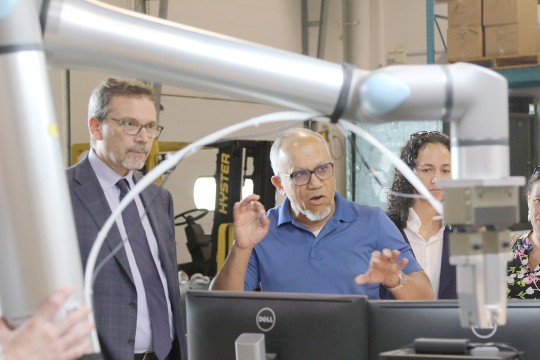News by Topic: Imaging Science
-
January 28, 2025

William H. Sanders named RIT’s 11th president
The dean of Carnegie Mellon’s College of Engineering is praised for his research credentials, success in global partnerships and entrepreneurship, and strong student engagement. He starts at RIT July 1.
-
January 14, 2025

RIT professor leads research showing true structure of the iconic Ring Nebula
Scientists now have obtained the clearest three-dimensional view of the nebula, thanks to a research team led by Carlson Center for Imaging Science and School of Physics and Astronomy Professor Joel Kastner.
-
December 6, 2024

New NASA, USGS funding continues RIT partnership with Landsat
RIT researchers have been a partner with Landsat projects for decades, and a group is now helping the program prepare for its next iteration with Landsat Next.
-
November 21, 2024

In and out of Africa
Africa is rich in natural resources and contains one of the most diverse ecosystems across the globe. The Sahara Desert itself is larger than the continental United States. With all the unique landscapes, wildlife, and growing urban areas, more than 30 RIT faculty have recognized the importance of traveling to the continent, all backed by RIT Global.
-
November 19, 2024

Student spotlight: Outside opportunities provide academic growth
A research project during Mohammad Saif's undergraduate career drew his attention to imaging, and now he has focused his academic career in remote sensing. Opportunities outside of the lab and the field have helped him learn how to better communicate and discuss the impact of his work.
-
October 9, 2024

The color science of leaves in a western New York park is focus of RIT Press book
Black oak, crabapple, crimson maple—a color scientist finds inspiration in the woods in the new book Munsell Trees: A Season of Leaves and Colors, published by RIT Press.
-
August 29, 2024

RIT aids in global climate solution initiatives
The Exchange plans to build a 400,000-square-foot campus on Governors Island, in the West River, next to the Statue of Liberty. One of the new facilities will be a state-of-the-art building with a serpentine roof that resembles a roller coaster with a solar canopy.
-
June 21, 2024

Cultural heritage imaging system expands international impact to South America
Led by Professor Juilee Decker, Professor David Messinger, and Professor Roger Easton Jr., the development of the MISHA system was originally planned to help small- to medium-sized cultural institutions in the United States.
-
May 13, 2024

Graduate Joseph Casale ready to return to Malaysia as a Fulbright awardee
Joseph Casale had hardly been on a plane when he traveled to Malaysia to do research a year ago. Now, he gets the opportunity to do it again.
-
April 22, 2024

Imagine RIT returns with nearly 400 exhibits
The Rochester Beacon highlights the upcoming exhibits at RIT's Imagine RIT: Creativity and Innovation Festival.
-
April 22, 2024
-
April 12, 2024

Imagine RIT: Creativity and Innovation Festival set for April 27
Detecting deepfakes, a device to help grocery stores like Wegmans inspect strawberries and reduce waste, and even the economic impact of Taylor Swift are just a few of the nearly 400 exhibits at this year’s Imagine RIT: Creativity and Innovation Festival.








